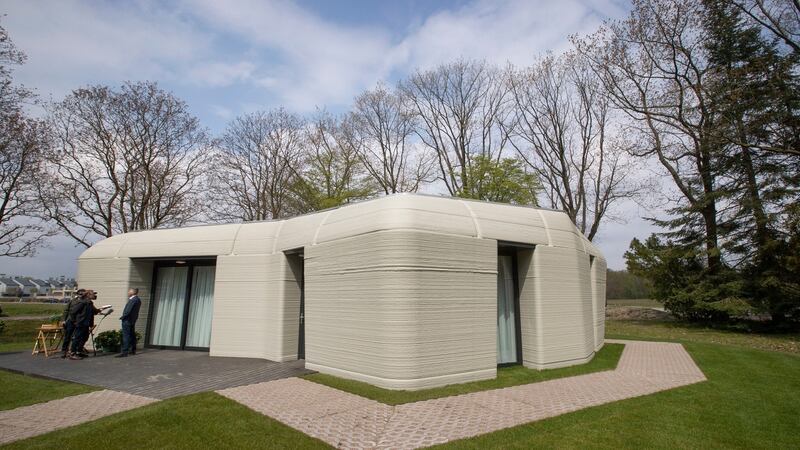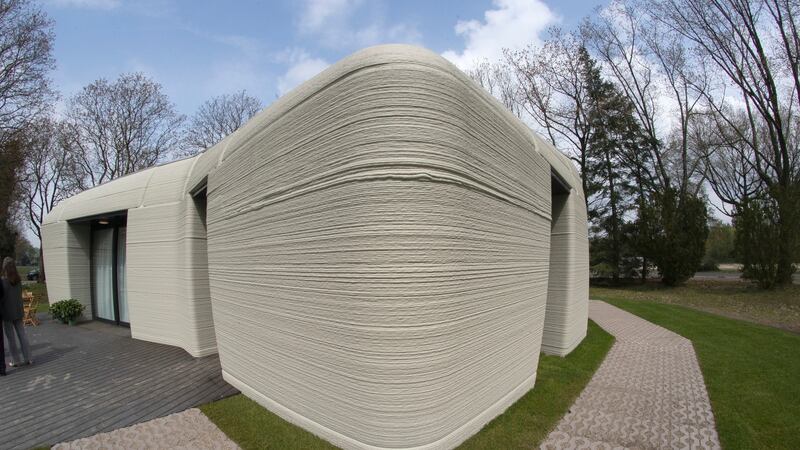A Dutch couple have become Europe’s first tenants of a fully 3D printed house in a development that its backers believe will open up a world of choice in the shape and style of the homes of the future.
Elize Lutz (70) and Harrie Dekkers (67), retired shopkeepers from Amsterdam, received their digital key – an app allowing them to open the front door of their two-bedroom bungalow at the press of a button – on Thursday.
“It is beautiful,” said Lutz. “It has the feel of a bunker – it feels safe,” added Dekkers.

Inspired by the shape of a boulder, the dimensions of which would be difficult and expensive to construct using traditional methods, the property is the first of five homes planned by the construction firm Saint-Gobain Weber Beamix for a plot of land by the Beatrix canal in the Eindhoven suburb of Bosrijk.
In the last two years properties partly constructed by 3D printing have been built in France and the US, and nascent projects are proliferating around the world.
But those behind the Dutch house, which boasts 94sq metres of living space, are said to have pipped their rivals to the post by being the first legally habitable and commercially rented property where the load-bearing walls have been made using a 3D printer nozzle.
“This is also the first one which is 100 per cent permitted by the local authorities and which is habited by people who actually pay for living in this house,” said Bas Huysmans, chief executive of Weber Benelux, a construction offshoot of its French parent company Saint-Gobain.
The first completed home of Project Milestone, a partnership with Eindhoven University of Technology and the Vesteda housing corporation, was due to be put on the rental market in 2019, but the challenges of the architect’s design, which involved overhanging external walls, caused delays.
Robotic arm
The 3D printing method involves a huge robotic arm with a nozzle that squirts out a specially formulated cement, said to have the texture of whipped cream. The cement is “printed” according to an architect’s design, adding layer upon layer to create a wall to increase its strength.

The point at which the nozzle head had to be changed after hours of operation is visible in the pattern of the new bungalow’s walls, as are small errors in the cement printing, perhaps familiar to anyone who has used an ink printer.
But while it is early days, the 3D printing method is seen by many within the construction industry as a way to cut costs and environmental damage by reducing the amount of cement that is used. In the Netherlands, it also provides an alternative at a time when there is a shortage of skilled bricklayers.
The new house consists of 24 concrete elements that were printed layer by layer at a plant in Eindhoven before being transported by lorry to the building site and placed on a foundation. A roof and window frames were then fitted, and finishing touches applied.
By the time the fifth of the homes is built – comprising three floors and three bedrooms – it is hoped that construction will be done wholly on-site and that various other installations will also be made using the printer, further reducing costs.
“If you look at what time we actually needed to print this house it was only 120 hours,” Huysmans said. “So all the elements, if we would have printed them in one go, it would have taken us less than five days because the big benefit is that the printer does not need to eat, does not need to sleep, it doesn’t need to rest. So if we would start tomorrow, and learned how to do it, we can print the next house five days from now.”
€800 a month
Lutz and Dekkers, who have lived in four different types of home in the six years since their two grown-up daughters left the family home, are paying €800 a month to live in the property for six months from August 1st after answering a call for applicants on the internet. “I saw the drawing of this house and it was exactly like a fairytale garden,” said Lutz.

The market rent would normally be twice that being paid by the couple. “Did we earn money with this first house? No,” said Huysmans. “Do we expect to lose money on house number two, three, four and five? No.
“With 3D printing you generate a huge creativity and a huge flexibility in design,” he added. “Why did we do so much effort to print this ‘rock’? Because this shows perfectly that you can make any shape you want to make.”
Yasin Torunoglu, alderman for housing and spatial development for the municipality of Eindhoven, said: “With the 3D-printed home, we’re now setting the tone for the future: the rapid realisation of affordable homes with control over the shape of your own house.” – Guardian









